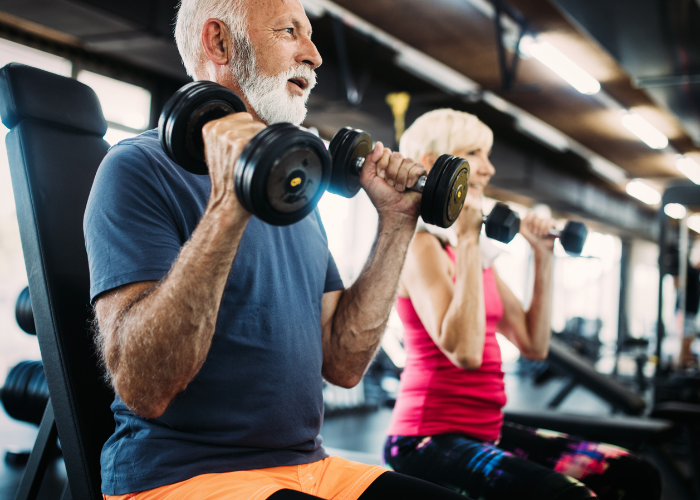Exercise and MS
27 September, 2021
By Yvonne Learmonth and Adam Browne
How does exercise help with MS?
Many of the symptoms associated with MS can be reduced through physical exercise. Exercise is a great way to stay strong, control weight, improve fitness and reduce the impact of specific MS symptoms.
The reported benefits of regular physical activity include:
- Reduced fatigue levels
- Improved endurance (cardiovascular fitness)
- Improved balance and coordination
- Improved muscle strength
- Improved posture and flexibility
- Improved mood, confidence and sense of wellbeing
- Improved alertness and concentration
- Improve ability to do everyday tasks
- Reduce risk of falls
- Optimise symptom recovery after a relapse
- Increased energy levels
While managing the symptoms of MS, exercise represents a crucial tool and is an important approach for improving health and wellness. Unfortunately, inactivity invites symptoms such as fatigue, poor strength and poor fitness. If someone is feeling fatigued, they might be less likely to exercise, and as a result they will have even more fatigue over time. Being inactive also raises the risk of developing other chronic health conditions. If you remain inactive, alongside MS, you are at an increased risk of developing heart disease or diabetes too.
There is scientific evidence that exercise is associated with meaningful outcomes for people with MS, and these outcomes range from the cellular level right through to effects on quality of life. Research has indicated that people with MS who engage in exercise have better brain health based on magnetic resonance imaging (MRI), better thinking and memory (cognition), and increased mobility and cardiovascular health. Plus, people with MS who engage in exercise have less fatigue, depression, anxiety, pain, and better sleep quality and quality of life.
Is exercise safe for people with MS?
Yes! Exercise is not associated with any greater risk for people with MS than for healthier individuals. Research has shown that exercise is not associated with increased risk of relapse or risk of adverse events for people with MS.
What type of exercise is best / recommended for MS?
There is so much evidence showing the benefits of aerobic exercise, resistance training and balance exercises in people with MS. Balance exercises are developed by experts to help train a person with MS to improve stepping, standing and balance. These exercises can be practiced unsupervised at home using a balance board system such as computer-based technology. It is important to practice balance exercises in a safe environment to reduce any risk of falls. Balance exercises can also be practiced when supervised by an accredited health professional such as a physiotherapist.
Exercise performed at least 2 times per week at a moderate intensity has been shown to increase aerobic capacity and muscular strength. People with MS who are 18 years of age or over and have mild to moderate levels of disability should follow the guidelines below, which are from the Adapting Your Lifestyle : A Guide for People with MS.
For those with a general level of fitness and experience
These are people who are not physically active on a regular basis.
- Moderate aerobic exercise 2 to 3 times per week: upper body exercises such as arm cycling or seated shadow boxing (boxing without an opponent), lower body exercises such as walking or leg cycling and combined body exercises such as using an elliptical trainer.
- Moderate strength training exercise 2 to 3 times per week which may include using weight machines, free weights and cable pulleys.
For those with an advanced level of fitness and experience
These are people who regularly participate in an exercise program and/or people who are seeking greater benefits from exercise training.
- Moderate to vigorous aerobic exercise 5 times per week which include running or road cycling.
- Moderate to vigorous strength training exercise 2 to 3 times per week, which may include using weight machines, free weights and cable pulleys.
For those with more severe disability
- Breathing exercises, flexibility exercises and exercises of the arms and legs for up to 20 minutes a day (10 minutes a day for EDSS 8.0+) 3-7 times per week. Refer to the National MS Society physical activity recommendations for further details.
Stretching & Balance Exercises
- Suitable balance exercises include exercises undertaken when standing, minimising upper limb support and reducing the base of support. Examples can be found on the Physiotherapy Exercise website (www.physiotherapyexercises.com)
- Can be performed in a variety of settings including home, community centre or gym
- Can be performed on most days of the week
- Stretching exercises can be performed using gravity or resistance bands
- Balance exercises can be performed by challenging one normal sitting and standing posture
- Can be useful to relieve muscle spasms and cramps
- Can improve relaxation and sleep patterns
- Can improve posture and flexibility
- Can reduce fatigue
Overcoming barriers for exercising
Fatigue
Fatigue is common in MS. Exercise and fatigue management education strategies will actually help your fatigue level in the long term.
Heat Sensitivity and MS
Physical and sensory symptoms may temporarily increase with small increases in environmental or body temperature. People with MS should be encouraged to keep cool and well hydrated during exercise sessions, for example, using cool clothing and try to exercise inside or in the shade.
Research is continuing to address what exercise and strategies are best for fatigue and heat sensitivity; for now it is recommended to follow the Physical Activity Guidelines, remembering to build up to these guidelines slowly. Stretching exercises are important too, and continuing these when fatigue levels, or temperatures, are high is still important.
Finding support
Support to help you exercise is not to be underestimated. Research indicates that learning about exercise, working with others to overcome your barriers and identifying facilitators to exercise will make you more successful. Tell your friends, family, work colleagues and neighbours about the benefits of exercise for you and tell them that you want to be more physically active, and they might join you too. Exercise is beneficial for everyone.
You might seek out help from a physiotherapist or exercise physiologist to give you specific instructions, ask them to help you overcome any exercise barriers you might have and make sure they know about the Physical Activity Guidelines. The Support & Services resource on MS Australia’s website can point you in the right direction for finding a local physiotherapist.
Using technology to your advantage
Your physiotherapist or exercise trainer may live far from you, but you can still access them using the telephone, email and telehealth options for ideas and advice.
Online videos and resources are engaging and will offer education on exercises for people with MS. Suggested websites are listed below.
Mobile apps for your smartphone are useful for monitoring physical activity, connecting with professionals over video chat and tracking your progress. Downloading these apps to your smartphone is very easy, and many are free. Suggested mobile apps available at the time of publication are listed below.
Wearable technologies such as digital devices worn as a wristwatch or band, can track your step count, heart rate and sleep. Wearables allow you to monitor your activity without thinking about it.
How do I get started with my exercise program?
Before starting any exercise program, it is always important to discuss with your GP or healthcare team your intentions and expectations to make sure exercise is safe for you. It is then a good idea to consider seeking help and advice with the prescription of your program by making an appointment with an exercise physiologist, your physiotherapist or physical therapist who will be able to design an individual program for you. Your physiotherapist or exercise physiologist will be able to assess and develop an appropriate exercise program and monitor you through regular consultation or supervision. Listed below are some key tips and ideas to assist with getting started with your exercise program and some ideas to assist with motivation:
Start slowly with any new exercise program and don’t try to do too much, too soon. Starting slowly allows your body get used to the new activity and adapt as well as helping you to determine the appropriateness of your exercise program and if it is comfortable for you. Over time, as your abilities and fitness levels change, you can increase and adjust your program appropriately
- Warm up and cool down
- Be aware of fatigue as this is one of the most common symptoms of MS. It is important to balance exercise with rest and to keep cool while you exercise
- Doing something is better than doing nothing
- Do something that is realistic & that fits well into your life
- Find a local walking group
- Exercise with someone else
- Do something you enjoy
- Schedule it into your week in advance
- Think about the time of day you exercise
- Monitor post exercise fatigue levels
- Take breaks and recover well
- Choose suitable exercise
- Do shorter more frequent sessions if need be (at least 10 minutes)
- Alternating and vary exercises (upper/lower body, cardiovascular/strength exercises)
- Set yourself goals using the SMART technique (Specific, Measurable, Attainable, Relevant, Time Frame)
- If you have an exacerbation, take a break and when you resume: reduce intensity and or duration and gradually build up
Some key points to remember about exercise and MS:
- Doing something is better than doing nothing
- Exercise will NOT make your MS worse
- Start slowly and gradually increase activity
- Choose enjoyable/motivating activities
- Exercise with others or in a group
- Choose activities that fit conveniently into your weekly routine
- Be sensible about resting and recovering
- Monitor your progress
Online Resources
- Exercise is Medicine Australia www.exerciseismedicine.org.au
- Multiple Sclerosis Australia www.msaustralia.org.au – the national website of MS Australia
- Find an Accredited Exercise Physiologist www.essa.org.au
- Find an Accredited Physiotherapist www.physiotherapy.asn.au
- Exercise Right www.exerciseright.com.au
- Yoga and Non-Cardio Exercises: Your Allies in Managing MS Symptoms and Improving Overall Health– telelearning brought to you by the National MS Society and Can Do MS
- Workout Your Worries: Anxiety and Exercise in MS– telelearning brought to you by the National MS Society and Can Do MS
- Your Mind is a Muscle, Too: The Relationship Between Exercise and Cognition- telelearning brought to you by the National MS Society and Can Do MS
- ChairFit with Nancy– series of free exercise videos developed by a physical therapist with years of experience working with people with MS.
- The MS Trust’s (United Kingdom) series of exercise videos for people with MS can be done in a seated or standing position to address balance, endurance, strength and flexibility.
- 14 Weeks to a Healthier You – free, personalized, web-based physical activity and nutrition program targeted to people with mobility limitations, chronic health conditions and physical disabilities. Created by National Center for Health, Physical Activity and Disability (NCHPAD), the program can help you get moving and make healthy nutrition choices.
- The Canadian Physical Activity Guidelines for Adults with Multiple Sclerosis can help adults with mild to moderate disability, resulting from relapsing or progressive forms of MS, to improve their fitness.
- The Aquatic Physical Therapy and MS video produced by Laura Diamond, MS, PT, Diamond Physical Therapy Associates, PC, and Jill McElligott, PT, DPT, offers an introduction to the potential benefits of aquatic physical therapy for managing MS symptoms and enhancing fitness. It also provides interviews with a neurologist, a physiatrist and an aquatic physical therapist, all of whom specialize in working with people with MS, as well as with people with MS about their perspectives on aquatics exercise.
- Health Focused Mobile App Examples: MSAA — My MS Manager and Charity Miles
References
- Klaren RE, Motl RW, Dlugonski D, Sandroff BM, Pilutti LA. Objectively quantified physical activity in persons with multiple sclerosis. Arch Phys Med Rehabil. 2013;94(12):2342–8.
- Motl RW, Pilutti LA. The benefits of exercise training in multiple sclerosis. Nat Rev Neurol. 2012;8(9):487–97.
- Pilutti LA, Platta ME, Motl RW, Latimer-Cheung AE. The safety of exercise training in multiple sclerosis: a systematic review. J Neurol Sci. 2014;343(1–2):3–7.
- Moore G, Durstine JL, Painter P, Medicine AC of S. ACSM’s Exercise Management for Persons With Chronic Diseases and Disabilities, 4E. Human Kinetics; 2016.
- Latimer-Cheung AE, Pilutti LA, Hicks AL, Martin Ginis KA, Fenuta A, Mackibbon KA, et al. The effects of exercise training on fitness, mobility, fatigue, and health related quality of life among adults with multiple sclerosis: a systematic review to inform guideline development. Arch Phys Med Rehabil. 2013;94(9):1800–28.
- Weikert M, Dlugonski D, Balantrapu S, Motl RW. Most Common Types of Physical Activity Self-Selected by People with Multiple Sclerosis. Int J MS Care. 2011 Jun;13(1):16–20.
- Agiovlasitis S, Beets MW, Motl RW, Fernhall B. Step-rate thresholds for moderate and vigorous-intensity activity in persons with Down syndrome. J Sci Med Sport Sports Med Aust. 2012 Sep;15(5):425–30.
- Pilutti LA, Greenlee TA, Motl RW, Nickrent MS, Petruzzello SJ. Effects of exercise training on fatigue in multiple sclerosis: a meta-analysis. Psychosom Med. 2013;75(6):575–80.
- Sangelaji B, Smith CM, Paul L, Sampath KK, Treharne GJ, Hale LA. The effectiveness of behaviour change interventions to increase physical activity participation in people with multiple sclerosis: A systematic review and meta-analysis. Clin Rehabil. 2016;30(6):559–76.
- Dalgas U, Stenager E, Exercise and disease progression in multiple sclerosis; can exercise slow down the progression of multiple sclerosis? Ther Adv Neurol Disord, 2012; 5 (2) 81-95 2.
- Dalgas U, Stenager E, et al. Multiple sclerosis and physical exercise: recommendations for the application of resistance-, endurance- and combined training. Mult Scler, 2008; 14(1): 35-53. 3.
- Morrison EH, Cooper DM, et al. Ratings of perceived exertion during aerobic exercise in multiple sclerosis. Arch Phys Med Rehabil, 2008; 89(8): 1570-4 5.
Dr Yvonne Learmonth
Yvonne is an Accredited Physiotherapist who specialised in Physical Activity research in multiple sclerosis. She has a PhD in rehabilitation and has many publications related to physical activity in MS. Yvonne currently lectures and conducts research in the school of Psychology and Exercise Science at Murdoch University, Perth, WA.
Adam Browne
To help us understand how exercise can make a difference, we would like to introduce Adam Browne. Adam is an Accredited Exercise Physiologist, specialising in Multiple Sclerosis rehabilitation and in strength conditioning. He has offered to share his knowledge and some practical tips via a series of articles to be shared here. For more information on Adam and to join him online, please visit: http://www.aep.net.au/.


